
Activism & Volunteering | Campus Life | Clubs & Orgs | Explore Campus | New Students |
Berkeley in a Nutshell
As an out-of-state student, there were two things people from my hometown said to me when I told them I was going to attend UC Berkeley: 1. “Wow, enjoy the California sun!” and 2. “You know, UC Berkeley is a very unique school.”
The first point was straightforward enough. Compared to Portland, Oregon, almost anywhere in the US is sunny (though Berkeley is cloudier than people give it credit). The second comment threw me for a bit of a loop though.
Cal was my dream school since I was a sophomore in high school, but in all honesty, I didn’t know much about it until I actually came here. Over the last two years, I’ve begun to understand why so many people pointed out UC Berkeley’s individuality to me. So, what’s so special about this place? Keep reading to learn what makes Cal, Cal!
Clubs & Classes for All
UC Berkeley has over 1,200 Registered Student Organizations (RSOs), which means there’s something here for everyone. Clubs unite members based on a shared identity, interest, sport, career field, or commitment to service. Aspiring filmmakers might make their directorial debut in the Cinematic Arts & Production (CAP) Club, whereas femme-identified folks in the realm of tech might join the Association of Women in EE&CS.
If you’re looking to find the club that’s the right fit for you, be sure to check out UC Berkeley’s biannual club fair, Calapalooza.
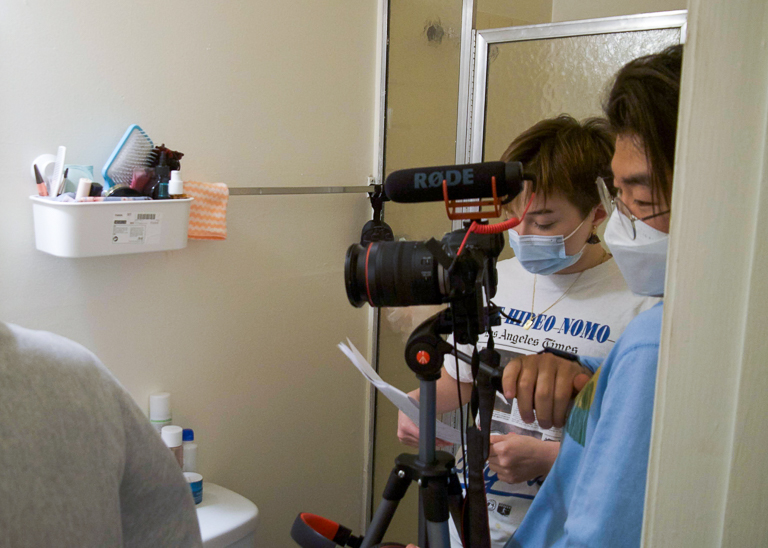
Nina (left) and her Director of Photography, Sean, on the set of their CAP Club short film, “Still Deciding.”
“DeCal” is another term I saw thrown around on the internet before I came to Berkeley—and one I had very little understanding of. Put simply, DeCals are student-created and facilitated UC Berkeley courses (funded by the ASUC) that cover some of the gaps in our university’s traditional curriculum. The range of DeCals offered is far and wide. A fellow officer of the Nikkei Student Union that I’m a part of teaches the Wild and Fermented Foods, where students learn how to make sourdough bread and forage in the Bay Area. My roommate, an art practice major, enrolled in UCBUGG: 3D Modeling & Animation during our freshman year and created an animated short.
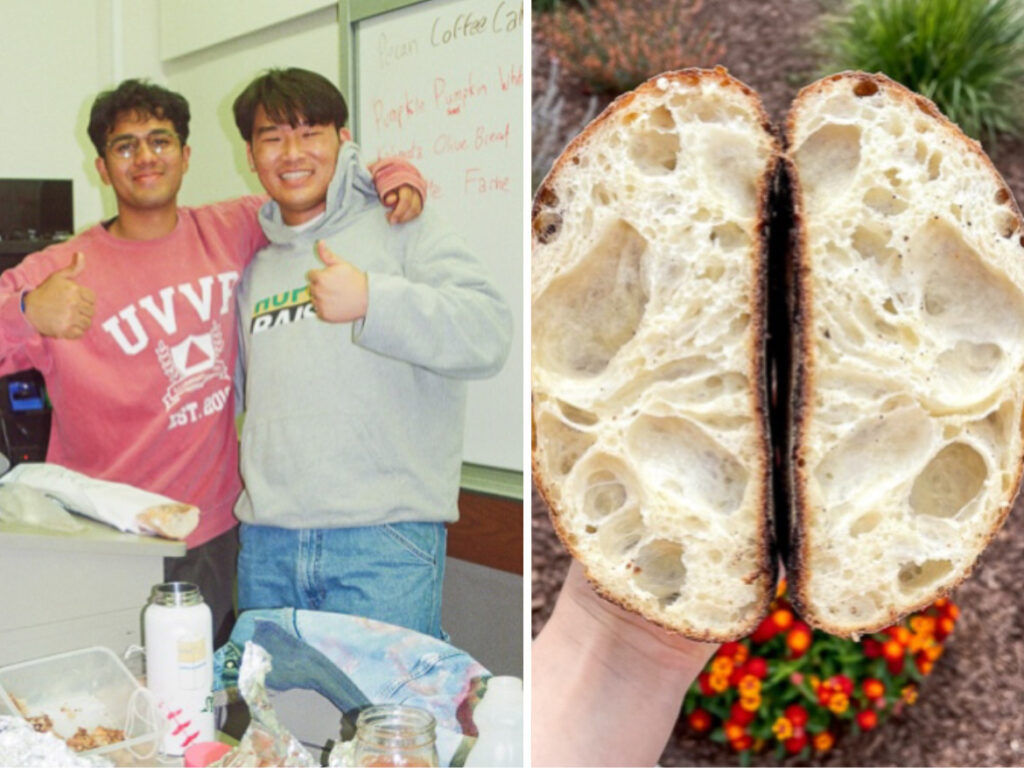
Stephen (right) shows off some of the foods he and his students have made in the Wild and Fermented Foods DeCal.
To discover DeCal courses, peruse the DeCal website. To enroll for fall semester, most classes are posted in mid-August; for spring semester, most classes are posted in mid-January.
Spotlight: Cal Raijin Taiko
Cal Raijin Taiko blends the line between a cultural organization and an interest-based organization. Taiko is the art of traditional Japanese drumming, and it features both music and dance. Historically, taiko has been a tool for Nikkei individuals—those with Japanese ancestry—to connect with their ancestral heritage and unite their community. Raijin member Halle Fukawa explains that it’s also a way to “make some noise when it feels like our voices aren’t being heard.”
Raijin was founded in 2005 by Tom Hata and Andrew Rowland. In the club’s early years, there was a lack of funding for real taiko drums, so members played on practice tire drums and used plastic folding chairs as stands. They stored their equipment in frat houses because they were unable to get cage space, which is where RSOs store their materials. As Halle explains, “This history certainly goes to show that taiko is about the players’ passion and community more than it is about having fancy equipment and costumes.”
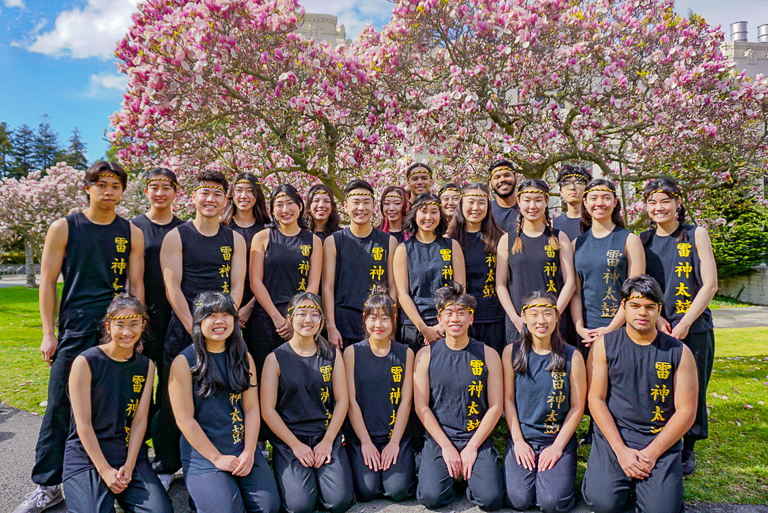
Members of Cal Raijin Taiko pose together in uniform.
While taiko is culturally Japanese and Japanese American, non-Japanese players are more than welcome. Tryouts happen in the fall, and the club hosts a DeCal about the history of taiko in the spring. Throughout the year, Raijin also offers community lessons at the Berkeley Buddhist Temple, performs at UC Berkeley functions like GBO Convocation, and brings the art of taiko to local elementary schools. Their final showcase is held in the spring.
Volunteerism & Activism
Cal is known for its long and rich history of social activism, exemplified with the counterculture Free Speech Movement of the early 1960s. Our students continue to be on the front lines of major fights for equality, liberation, and the safety of all people. Correspondingly, volunteerism is a key component of UC Berkeley’s culture. Our school is America’s number one producer of Peace Corps volunteers, and in 2020, our campus ranked ninth place out of all large US universities and colleges for the highest number of current volunteers.
To learn more about getting involved with the Peace Corps, schedule an appointment with the Cal Peace Corps Representative.
Volunteerism Spotlight: ACE Coaches
Every Saturday, ACE Coaches from UC Berkeley head over to San Francisco Chinatown’s YMCA to teach third through fifth-grade students from the community. They provide free academic support in math, science, and English, as well as cultural enrichment (i.e., learning about Chinese and Chinese-American culture, and their parallels to other cultures). Lesson planning is collaborative, and ACE coaches schedule themselves to teach on dates that work for them.
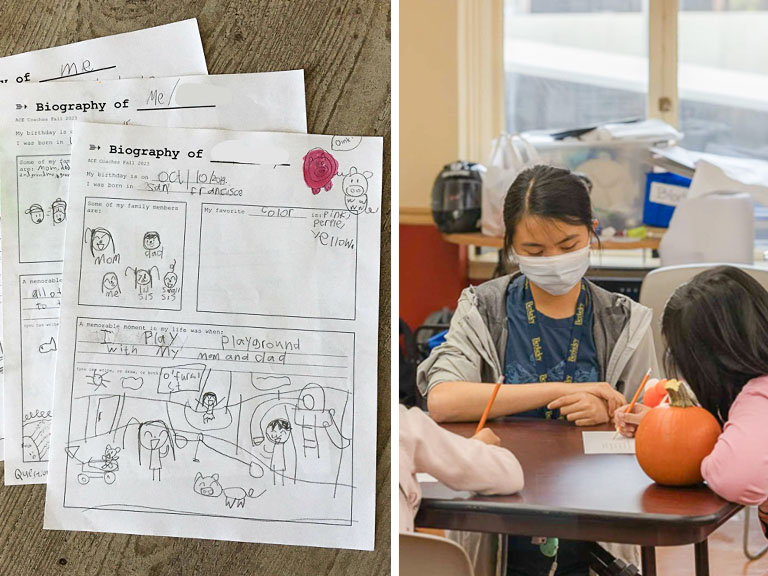
ACE Coaches help elementary schoolers excel. Photos by Aaron Wang and Hana Chang.
Cal’s ACE Coaches program was established in 2015. While the concept of an educational club offering lessons at afterschool programs isn’t uncommon, ACE Coaches’ integration with a specific community is noteworthy. Joanne Teh in Public Relations for ACE Coaches explains that their club was founded with the intention of mitigating the decline of San Francisco’s Chinatown and its vibrant community.
“This kind of decline is a trend that has sadly started to show itself in many Chinatowns across the nation,” Teh says. “While there are multiple initiatives out there that combat the decline of Chinatowns, every effort is highly specialized to the community they serve, and ACE Coaches is unique in that sense.”
Inclusive Athletics
It’s easy to stay physically active at UC Berkeley. Every year, more than 8,000 students join our flourishing Intramural (IM) Sports program, which offers both recreational and competitive opportunities. IM Sports are a way for students to continue playing the sports they grew up loving, or to try something completely new.
If organized sports aren’t your thing, you can stay in shape using any of the Recreational & Wellbeing facilities across campus. Whether your preferred workout is a swim at Spieker Pool, weightlifting in the Recreational Sports Facility, or climbing, Cal has got you covered.
Spotlight: Cal Quadball
Cal Quadball is undoubtedly one of the most unique athletic opportunities available at UC Berkeley. Inspired by the Harry Potter series written by J.K. Rowling, quadball combines elements of rugby, basketball, and dodgeball to create an unforgettable, full-contact sport.
Berkeley’s quadball history began in 2009, when two students got together and created The Quidditch League at Berkeley, which would later become Cal Quidditch, and then finally Cal Quadball. Their team was part of a greater movement across the world to create a quidditch league outside of the realm of Harry Potter.
Chloe Foo, a member of Cal Quadball, emphasizes that quadball has always been a coed sport for people of all gender identities. “In a political climate that vilifies and puts barriers around trans people and kids in sports,” they write, “this sport taught me that it doesn’t have to be that way.”
Quadball serves to uplift trans people, so following controversy surrounding J.K. Rowling’s transphobic comments on social media, the US Quidditch League rebranded itself into “US Quadball.” Cal Quadball and other college teams followed suit.
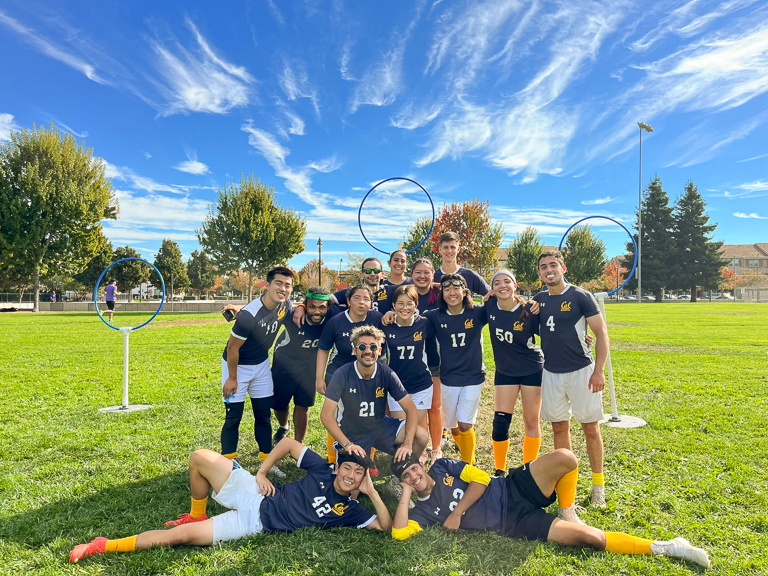
Members of the Cal Quadball team pose in uniform on the field.
Last November, Cal Quadball won the Chandra Classic VI Tournament against The Second Stars and UCLA Quadball. In 2022, Cal Quadball was titled West Regional Champions. This spring, they took home a treasured national title at the 2024 US Quadball Cup in Round Rock, Texas.
If you’re interested in giving this dynamic sport a try, you can follow @calquidditch on Instagram.
Entrepreneurial Spirit
Did you know that UC Berkeley is the number one public university for start-up founders? Our community is buzzing with innovation, so if you’re looking to build the product or start the company of your dreams, you’re in the right place.
Berkeley SkyDeck is an initiative that supports start-ups created by UC Berkeley students, alumni, and faculty. By commercializing the university’s research, it helps information reach the broader public. SkyDeck was formed through a partnership between UC Berkeley’s College of Engineering, Haas School of Business, and the Office of the Vice Chancellor for Research.
Every six months, the SkyDeck Accelerator Program grants 20 cohort start-ups a $200,000 investment to help them grow and achieve their goals. While this cycle’s Cohort has already been selected, you can still stay updated about Berkeley SkyDeck and its upcoming Cohort selection interviews.
Entrepreneurship Spotlight: NovaXS
In 2020, Alina Su and her team founded Nova XS, a medical device company dedicated to making medication delivery more accessible and pain-free. Su and her team participated in the Berkeley SkyDeck program, and were winners of the Pad-13 Pitch Competition under SkyDeck and the Fall 2021 Collider Cup hosted by the Sutardja Center of Entrepreneurship & Technology at UC Berkeley.

A screenshot of the NovaXS website.
Alina’s interest in healthcare and biotech started from a young age. She was exposed to the reality of medical injections through her sister, who has growth hormone deficiency, and learned about neurodegenerative treatments through her first job in healthcare. These experiences dovetailed to create her vision for NovaXS: “To build a needle-free, transformative, and interactive drug delivery platform and present to the market a world-leading and life-changing biological proteins that treat chronic diseases.”
Embrace Your Community
My father, a native Japanese speaker, likes to mention “colors” when discussing higher education institutions. Rather than referring to the actual colors that represent the school’s branded identity, this term concerns its character. What values does it hold? What are its students like? What do its alumni go on to do?
When I told my father that I was thinking of committing to Berkeley, he noted the strength of its colors. After having been here for a year and a half, I finally understand what he means. I also understand why people say there’s nowhere else like UC Berkeley. I truly believe that our commitment to creativity, innovation, activism, and inclusivity makes us stand out.
Thanks for taking the time to learn about this wonderful school’s students, groups, and culture, and stay tuned for a second article detailing some of the unique features of our campus.
Nina Takahashi is a second year at UC Berkeley majoring in film and minoring in Japanese.
Want More?
- Discover student clubs & orgs at Cal.
- Quiz yourself on common Berkeleyisms.
- Learn how one senior stays happy at Cal.